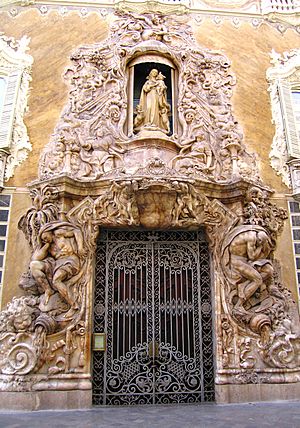Ignacio Vergara facts for kids
Ignacio Vergara Gimeno (born in Valencia, Spain, in 1715 – died there on April 13, 1776) was a famous Spanish sculptor from the Baroque period. He created many beautiful sculptures, especially in stone and wood.
Contents
Early Life and Artistic Training
Ignacio Vergara started learning art in his father's workshop. His father, Francisco Vergara, was also a sculptor. Ignacio's brother, José Vergara Gimeno, also began his career there. However, José later became a painter instead of a sculptor. Ignacio also learned from other artists like Evaristo Muñoz and Konrad Rudolf. These early experiences helped him become a skilled artist.
Founding Art Academies
Ignacio Vergara was very important in the art world of his time. He helped start the Academia de Bellas Artes de Santa Bárbara. He even became its Director-General. This academy later changed its name to the Real Academia de Bellas Artes de San Carlos de Valencia. He was also recognized by the Real Academia de Bellas Artes de San Fernando in Madrid. This shows how respected he was as an artist and teacher.
Famous Sculptures and Art Style
Ignacio Vergara's most well-known work is the beautiful entrance (portal) of the Palace of the Marqués de Dos Aguas. He created this amazing stone sculpture based on a design by Hipólito Rovira.
Other important stone sculptures he made include:
- "Angels Venerating Mary" at Valencia Cathedral.
- Several artworks at the Iglesia de las Escuelas Pías in Valencia.
- A statue of Saint Anthony the Great at the Iglesia de San Martín y San Antonio.
- A statue of Saint Bruno in a chapel at the University of Valencia.
He also made large sculptures from wood. Most of his art is in the late Baroque or Rococo style. This style is known for being very decorative and fancy. One of his last works was a sculpture for King Charles III. This piece, found at the Palace of Justice, shows some newer Neoclassical ideas. This style was simpler and more classical.
See also
 In Spanish: Ignacio Vergara para niños
In Spanish: Ignacio Vergara para niños


